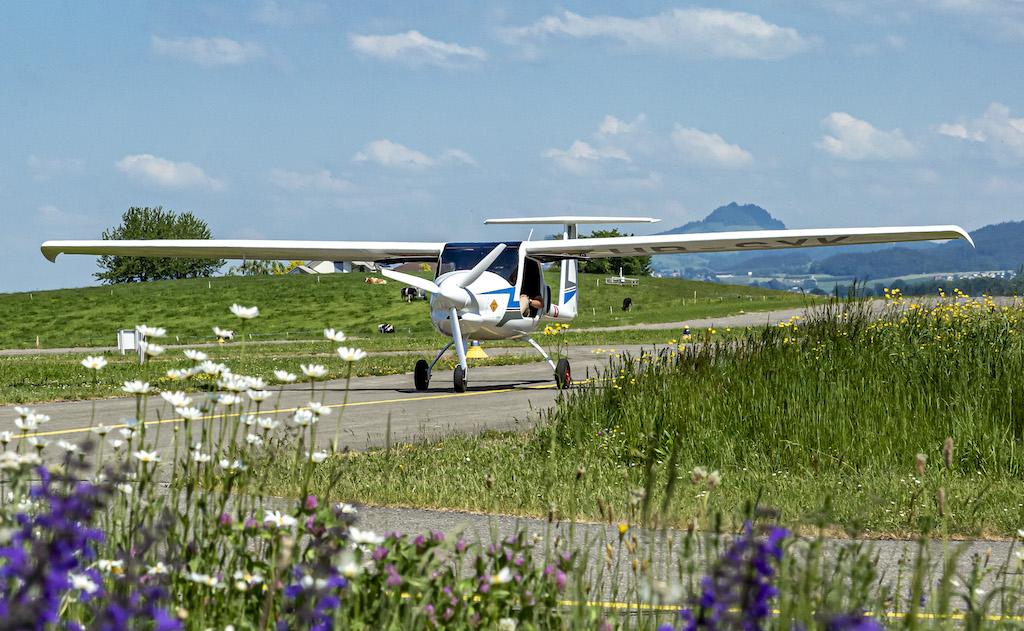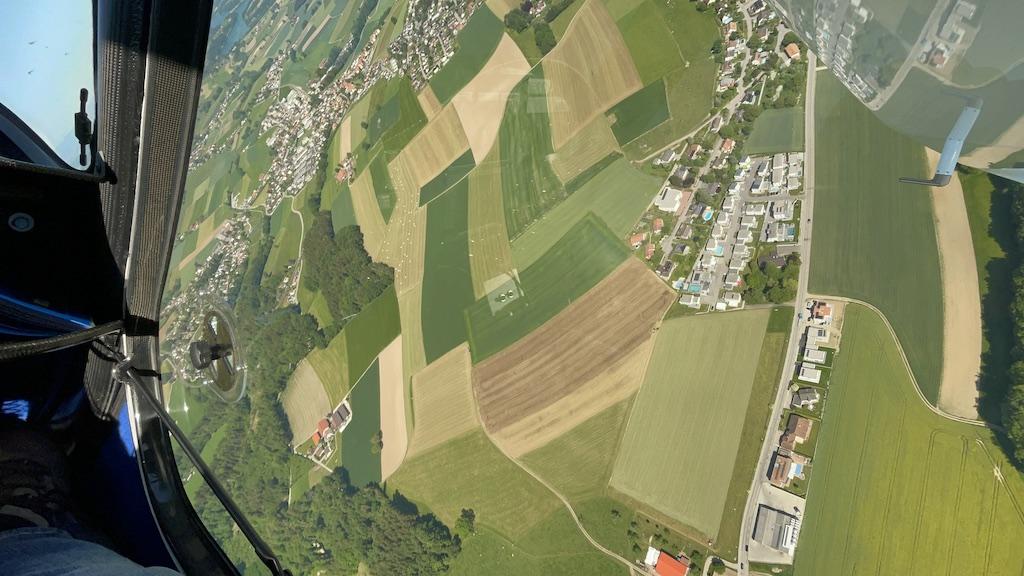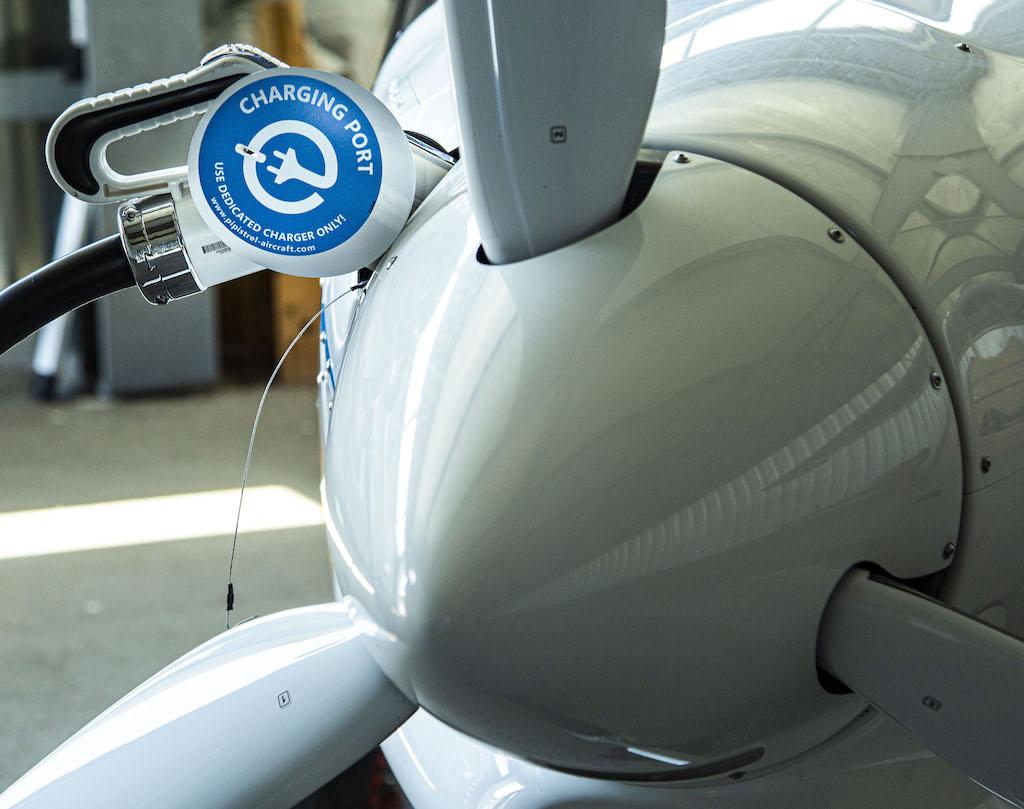
The Pipistrel Velis Electro taxis at Ecuvillens airfield in western Switzerland.
Our look at the first certified electric airplane continues with a flight on the Pipistrel Velis Electro.
After strapping in it was time to continue with the start-up process. The Velis Electro was clearly designed to be simple to operate. The aircraft has four cockpit switches. A safety guard in the powertrain will not activate the propeller unless the throttle is fully in the idle position. Unlike a conventional reciprocating engine where the propeller immediately begins to spin when the starter is engaged, the Velis Electro’s propeller doesn’t begin to spin until the throttle is moved forward to begin taxiing.
Another unique aspect of electric propulsion is the lack of warm-up time needed for takeoff. This was amply demonstrated as a Beechcraft Bonanza sat short of the runway for several minutes doing its pre-takeoff checks. We sat for multiple minutes as the Bonanza did its engine run-up, leaned the mixture, checked the magnetos and checked the propeller. Our engine wasn’t running while we waited.
After a quick check of the windsock, prepositioning the flight controls for the slight crosswind, and making a position call “en Francais” on CTAF, I moved the throttle forward. Power is delivered instantly and without hesitation. The noise level within the aircraft was remarkably quiet, and there were essentially no vibrations. This was especially noticeable since my last light aircraft flying was predominantly done in a restored PT-17 Stearman and a Robinson R-44 helicopter. The lack of noise and vibrations in those aircraft would be cause for concern. Flying in relative quiet and without vibrations is a refreshing experience.
The aircraft’s flight manual predicts a takeoff run of 791 ft. at sea level, standard-day conditions. The warmer-than-standard temperature conditions produced a slightly longer takeoff run using one notch of flaps (8 deg.). Quickly, we were climbing out toward the scenic mountains surrounding the famous village of Gruyeres at a brisk climb rate of 600 fpm.
We set the throttle to approximate 35-kW power, which resulted in 90 KCAS of cruise performance. This normally results in an endurance of up to 50 min., which leaves a 30-min. VFR reserve.
The high-aspect-ratio wing reminded me of a sailplane as we cruised through the thermal activity. The ailerons and elevator control forces were enjoyably light with the control stick. The Velis Electro has full-span flaperons, thus a turn made without coordinated use of the rudder will produce adverse yaw. The rudder movement required to make a coordinated turn was quite manageable.
Flight Handling Characteristics

Next, we explored the slow-flight handling characteristics. The Velis Electro is equipped with an aural angle-of-attack-based stall warning and a stick shaker. This was deliberately included in the aircraft design because of its intended mission as a training aircraft. As we slowed down, the aircraft gave plenty of warning of the usual characteristics of high AOA. The flight controls became sluggish, and some tactile vibration was noticeable from the empennage. As the AOA increased, the stall warning system activated and then progressed into the stick shaker close to the book value of 51 KCAS in the clean configuration. The aircraft still exhibited plenty of control and did not have a tendency to “drop off.”
It was then time to return to the traffic pattern so that our photographer could grab inflight videos. The aerodynamic sleekness of the aircraft was immediately apparent on downwind. The lack of drag kept the aircraft sailing along with only a minor decrease in the speed even with the throttle fully back at idle. While on base leg it was evident that a slip would be needed to bleed off enough airspeed to get the final notch of flaps (19 deg.) deployed. Even with the second notch of flaps the aircraft does not bleed speed. This handles more like an aerodynamically sleek sailplane in the pattern.
Again, the lack of noise and vibrations was a remarkable difference from conventional reciprocating-engine aircraft. This provides a wonderfully quiet cockpit environment, enabling a pilot to easily listen over the headsets without the shaking, rattles and loud noise. This improves the ability to maintain situational awareness.
I couldn’t help but grin while taxiing into the ramp. At my home airport I would be taxiing into the self-serve refueling rig where the cost of aviation gas is excessive at the FBO, which is “unfriendly” to general aviation.
Our photographer then jumped into the seat. I was surprised when the Velis Electro slipped past us on the takeoff roll. The noise level is a mere 60 dBA. It was possible to still hear the cowbells in the adjacent pastures. This would be a game changer at an airport such as Santa Monica with its restrictive noise abatement procedure where residents have the airport authority on speed-dial to register their complaints of aircraft noise. The lawn mowers and leaf blowers of those residents are far louder than the Velis Electro.
This will be a great asset for all of aviation because it will lessen the sound signature. Flight schools that operate in noise-sensitive communities will benefit from the quietness of the Velis Electro.
The transition for an already-certified pilot into the electric aircraft is a simple four-flight process, according to Corpataux. The first flight is an introduction to the engine characteristics and management of the batteries’ energy. The last flight is a cross-country to demonstrate the pilot’s proficiency in energy management.
There are currently 11 e-grid recharging facilities in Switzerland at partner flight schools that similarly operate electric aircraft. There are also recharging facilities at the Bern and Luzern airports. An aircraft that returns from a training flight with 35% of the “state of charge” (power remaining in the batteries) will require up to 60 min. for recharging to attain 95%. Pipistrel recommends a three-phase, 380-VAC connection to enable quick charging.
Reliability And Maintenance

These aircraft are game changers in terms of technological innovations and cost efficiency. Pipistrel’s Tine Tomažič explained that electric aircraft are much more upgradable. For example, the inevitable improvements in batteries will be easier to incorporate into the same aircraft.
Reciprocating engines are more complicated and prone to problems such as pre-ignition and detonation. Starting a reciprocating engine in excessively cold temperatures should normally be assisted by pre-heating the engine. And, of course, in excessively hot temperatures it is possible to vapor lock a fuel-injected engine, or with improper leaning procedures cause problems with the magnetos. An electric engine will have none of these issues.
The Velis Electro’s service ceiling is 12,000 ft., which brings up another advantage of electric aviation. The power output of its batteries or the engine does not diminish with increases in altitude. This is a contrast to the considerable loss of engine power in a normally aspirated reciprocating engine at higher density altitudes. Advisory materials for pilots venturing into high-density-altitude destinations such as the Rocky Mountains have warned for decades about the diminution of engine power.
The Velis Electro’s drivetrain has only one moving part, a ball bearing, which explains the lack of vibrations from the engine. The reduced number of moving parts dramatically increases the ease of maintenance and simultaneously decreases maintenance costs. The risk of malfunctions is further minimized due to a continuous health-monitoring system.
The TBO of the motor is 2,000 hr. There is an initial limitation of 500 hr. on the batteries, but as additional testing and operational experience are accumulated this will increase significantly. The batteries are replaceable without special skills. An exemption with the European Union Aviation Safety Agency (EASA) sets forth the requirements for licensed AMTs who complete a different training course specific to the Velis Electro.
In Part 3, we’ll discuss the challenges of certifying “leading edge” technologies such as those in the Velis Electro.
Velis Electro Points To A Sustainable Future, Part 1: https://aviationweek.com/business-aviation/aircraft-propulsion/velis-el…





